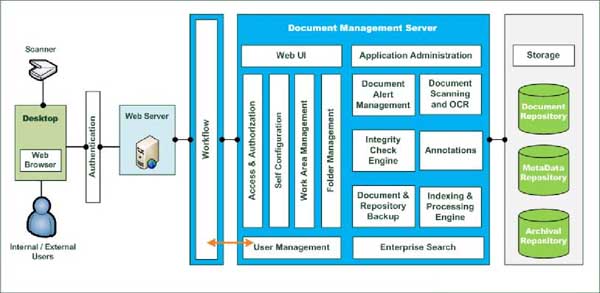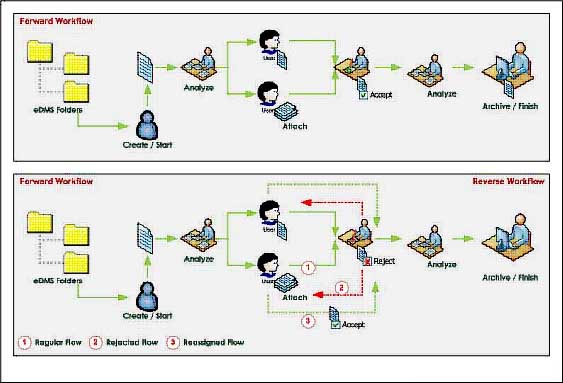Electronic Document Management
• Collaborate, Annonate and Revise Documents across the Enterprise
• Enterprise wide Workflow of Documents and Drawings
• Revision Control of Documents
• Manage Document Approval Stages

Electronic Document Management
A Unistal’s electronic Document Management System with Workflow (Unistal eDMSW) is a computer system used to track and store electronic documents and/or images of paper documents. Document management systems commonly provide storage, versioning, metadata, security, as well as indexing and retrieval capabilities.
Effective knowledge and information sharing is vital to any organization. Content management solutions are intended to help businesses manage and distribute information faster and more efficiently.
Today's world of information technology is all about accessing and managing information in a cost‐effective manner, saving valuable time and space.
Research shows that in any business 98 per cent of the documents are stored and archived for future reference after their current utility ends. Large spaces are required for storage of these documents, wasting valuable space. Stored documents are also exposed to the risk of damage, being misplaced or misfiled. Retrieving old documents is extremely time consuming as well as resource centric sometimes, additional manpower is required just to maintain them
A workflow consists of a sequence of connected steps. It is a depiction of a sequence of operations, declared as work of a person, a group of persons, an organization of staff, or one or more simple or complex mechanisms.
A workflow is a model to represent real work for further assessment, e.g., for describing a reliably repeatable sequence of operations. More abstractly, a workflow is a pattern of activity enabled by a systematic organization of resources, defined roles and mass, energy and information flows, into a work process that can be documented and learned. Workflows are designed to achieve processing intents of some sort, such as physical transformation, service provision, or information processing.
Workflow concepts are closely related to other concepts used to describe organizational structure, such as silos, functions, teams, projects, policies and hierarchies. Workflows may be viewed as one primitive building block of organizations.
Evaluating Architectures for Enterprise Class Solutions
The challenge of identifying and implementing a solution that aligns technology with business objectives typically falls into the hands of the enterprise architect. Architects are faced with implementing technologies that will keep the overall knowledge development within the enterprise and keep the maintenance costs to a minimum, while finding new ways of driving top‐line revenue growth. Architects therefore have to evaluate and identify solutions that enable them to do the following without affecting existing systems or adding personnel
Unlock new value from existing systems through,
- Dramatically improved usability of existing applications or systems
- Seamless integration of application, data and process
- Deliver new solutions that have the widest reach and the most effective experiences for users
- Deliver real‐time communication solutions that improve productivity and reduce communication costs within and across organizations
To help identify an effective solution for their organizations, CIO's and enterprise technology architects will benefit from a solution that addresses key business needs. eDMS solution contains the following Modules
Unistal are industry leaders in information management and high quality solution providers, empowering business users, developers and designers to create and deliver effective and compelling user experiences. Unistal’s eDMS provides a robust, end‐to‐end architecture for delivering Rich Internet Applications (RIAs), content and communications across multiple platforms and devices.
Deploying and Maintaining the eDMS Solution within an Enterprise
The eDMS solution is designed for easy deployment and maintenance within any standards‐ based enterprise infrastructure.
eDMS Deployment and Administration
As eDMS is developed using open source framework and technologies which is huge cost saving against proprietary licensing and easy for deployment and maintenance are as straightforward as managing any other application.
To provide enterprise administrators with flexibility in deploying the eDMS application within a managed networked computing environment or intranet, Unistal supports a common installation method and simple deployment methods.
eDMS Access anytime - any where

Unistal's document management solution with workflow handles documents by electronically storing, organizing, indexing and filing. They can be retrieved as & when required on a click of a button, without any loss of time.
- User can accesses unstructured data in the form of documents present in your organization and store them in a structured form.
- User can access any documents to his desktop and enables him to work with them, eliminating the need for paper‐based documents.
- It is a powerful document archival system, which ensures safety of documents, faster access to them and huge cost savings.
This technology will enable you to manage paper as well as electronic documents and files in a single system. Documents are electronic and can be retrieved easily for quick reference. Depending on your requirements we integrate a set of modules that provide a new level of information control and help you manage your data effectively.
The eDMS have two different modules of operation
Administration Module
- User Management
This module useful in the functions of Create / Update / Delete users. - Folder Management
This module is useful in the folders and sub folders management here authorized user can Create / Update / Delete folders or sub folders. - Access Management
This module is useful in assigning different roles and access rights to different folders for the different users. With this feature the application is completely secured towards unauthorized access keeping documents in safe hands - Department / Work Area Management
This module is useful in case of defining work area of the users. Here authorized users can Create / Update / Delete department or division or work area.
- Document Archival
It provides a central repository to archive high volume of documents that can be accessed and shared between multiple users, locations or the entire enterprise. Different document types and content are archived through rights based archival. - Document Management
It provides basic library services including check‐in/check‐out. - Document Versioning
It maintain different versions of the document - Retention Policy
Administrator is able to set user wise / department wise retention policy. - Document Scanning and OCR
It scans the document, after scan dynamic OCR is done with built in powerful OCR engine. - Document Indexing & Processing
Centralized indexing and post branch scanning along with Maker‐Checker scenario for document processing - Workflow
Centralized workflow where user can create new workflow and assign users to it and define set of rules to operate, also manage existing workflow system. Each user will have alert available on the dashboard. Also alerts available outside the eDMS through email - Annotations
User can mark annotations (remarks) on the existing image and it is viewable only to the concern users - Enterprise Search
The exhaustive document and folder searches on date, indexes and general parameters as well as full text search on image and electronic documents. - Check‐in / Check‐out
Users can Check‐out required document process work on the same and Check‐in again once user completes his work. In case user is not available for check‐in the checked‐out document administrator can force check‐in the same documents - Dash Board
There is separate dash board for each user. User can see his dash board once he logged in the eDMS system. There are certain handy information is available to act upon it for e.g. Checked‐out document list, recently modified and downloaded documents, User manual …etc. This helps out in fast decision making.
Forward Workflow
Workflow will have steps and each step will have one multiple tasks when user creates or manages workflow he will define series of steps and tasks and those will be followed as per sequence defined one by one this is forward workflow.
Reverse Workflow
When any user rejects certain step or task the workflow will move back to its previous step or task then workflow starts again with the previous steps or tasks this is reverse workflow. Only authorized user can reject the steps or tasks so reverse workflow by authority only.

- Comprehensive search capabilities with metadata to quickly locate the information
- Security and privacy eDMS enterprise‐class architecture maintains the confidentiality of user and corporate data. Organizations that fail to meet this requirement may face penalties for noncompliance and risk diminished marketplace reputation and customer goodwill.
- Users can modify security and privacy settings through an easy‐to‐understand graphical user interface, while enterprise administrators can implement security throughout an organization with the administration module
- Ease of deployment and maintenance eDMS architecture is design facilitates easy deployment, management, and can be maintained without requiring additional resources. Built in self installation and Configuration module towards easy deployment.
- Interoperability with existing systems eDMS seamlessly integrate with existing systems to enhance and extend their capabilities without negatively impacting their performance.
- Long‐term viability So that organizations can be confident that their investments will support future requirements as well as current short‐term needs, architects evaluate whether the platform is poised for long‐term stability and growth.
- Alert Engine Send email alerts to the users and administrators
- Workflow schedule wise with built in total security and alert management outside the eDMS system through email.
- Physical Storage location of the Repository folder Now administrator can browse and select storage location anywhere within the network thus saves data in case if systems crash, Business Continuity solution.
- Scan a document within DMS directly from the client system and store result into the database
- Built in OCR engine for saving dynamic metadata of the of the scanned document into the database
- Annotations engine where superior can remark on the scanned document and that will be viewable to the concern user only. Superior can mark annotations if he has permission to do it.
- Database and Repository backup & restore eDMS Admin can take full as well as selective backup of Database and Repository to another media.
- Make quick and accurate business decisions
- Comply with regulatory requirements
- Allows setting comprehensive policies for storing and retaining content for compliance
- Reduce duplicate document storage across the enterprise thus reduce storage, cost
- Remove old documents from the eDMS using built‐in retention engine thus reduce storage, saves document search time
- Improves customer responsiveness through agility for extended enterprise, powered by synchronizing content spread across information silos and disparate systems
- Identify and leverage opportunities with collaborative framework
- Business Continuity
- Strong Roles & Rights management based on User types.

Request a Callback

